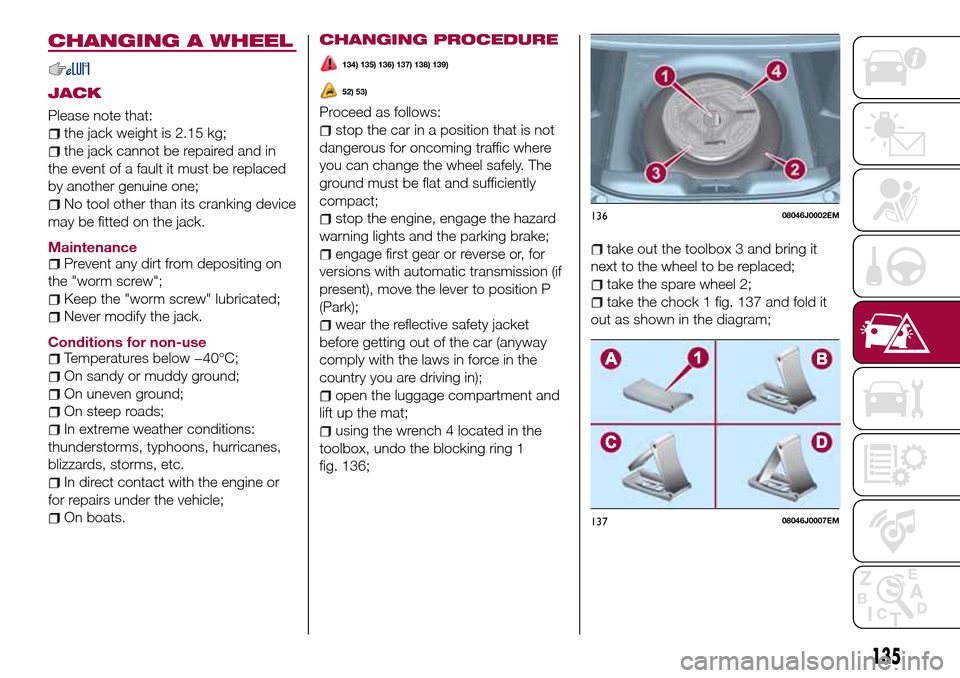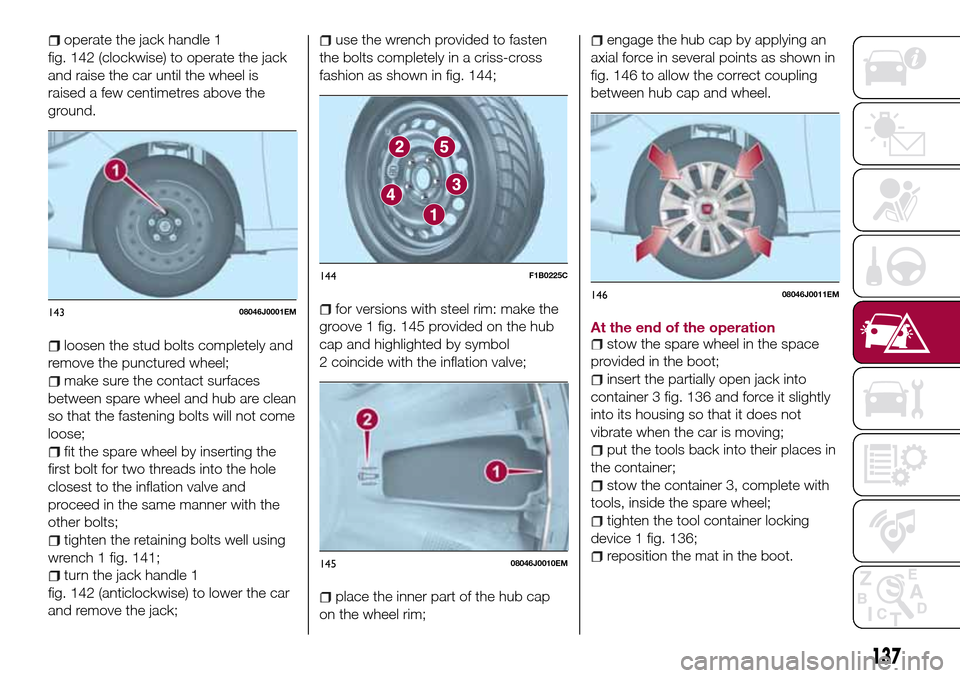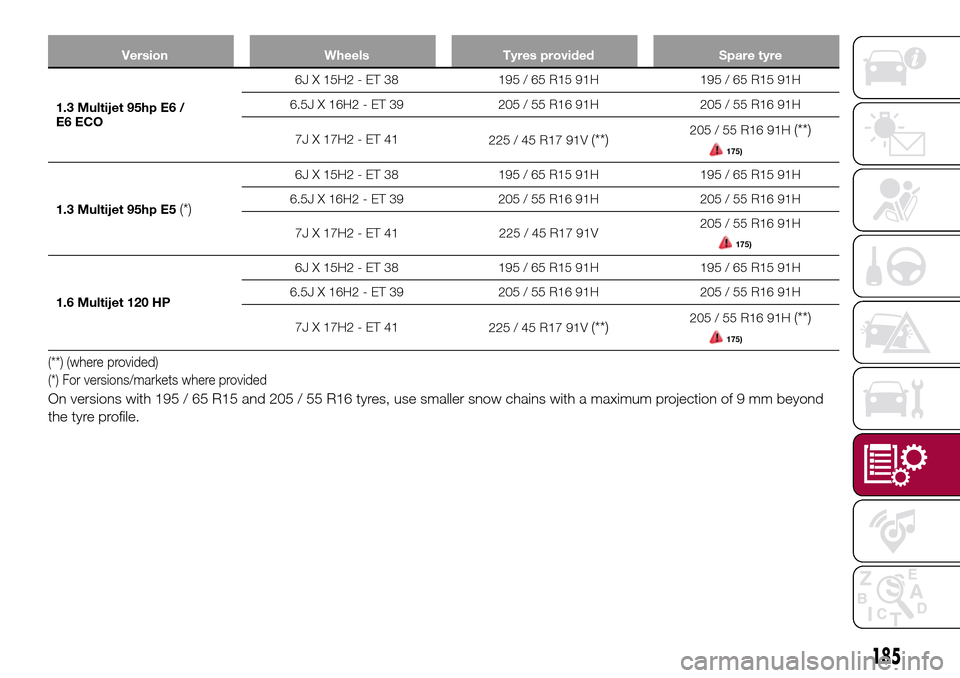2017 FIAT TIPO 4DOORS spare wheel
[x] Cancel search: spare wheelPage 40 of 240

LPG TANK
The car has a pressurised tank for
storing LPG in a liquid state. It is
toroidal and is located in the spare
wheel compartment with suitable
protection.
LPG tank certification
The LPG tank is certified in accordance
with the regulations in force.
In Italy, the tank has a life of 10 years
starting from the car registration date. If
the vehicle has been registered in a
country other than Italy, the duration
and the testing/inspection procedures
of the LPG tank can vary depending on
the national provisions in force in that
country. In all case, when the time limit
for your country has expired, go to a
Fiat Dealer to have the tank replaced.
LPG/PETROL SWITCH
This engine normally runs on LPG
except during starting when it runs on
petrol. Switching to LPG is automatic,
the warning light
1 fig. 50 on the
instrument panel, switches off.If you specifically want to use petrol,
press the button on the dashboard
fig. 51. If the LED located above the
button turns on, it indicates that
switching has taken place correctly.
Regardless of the last fuel system used,
at the following engine starting, after the
initial petrol stage, the system will
automatically switch to LPG.The bars 2 fig. 52 on the display
indicate the level of LPG in the tank.
To guarantee switching in full safety, the
actual change to the chosen fuel
system takes place depending on the
car usage conditions; it may not
therefore be immediate. Switching is
confirmed by the switching on/off of the
green warning light
on the
instrument panel.
When switching is requested, metallic
noise from the valves which pressurise
the circuit can be heard. For the
switching logic described above, a
delay between the valve ticking and the
switching off of the instrument panel
indication is completely normal.
50PGL00022
51PGL6J0032
52PGL00023
38
KNOWING YOUR CAR
Page 137 of 240

CHANGING A WHEEL
JACK
Please note that:
the jack weight is 2.15 kg;
the jack cannot be repaired and in
the event of a fault it must be replaced
by another genuine one;
No tool other than its cranking device
may be fitted on the jack.
Maintenance
Prevent any dirt from depositing on
the "worm screw";
Keep the "worm screw" lubricated;
Never modify the jack.
Conditions for non-use
Temperatures below −40°C;
On sandy or muddy ground;
On uneven ground;
On steep roads;
In extreme weather conditions:
thunderstorms, typhoons, hurricanes,
blizzards, storms, etc.
In direct contact with the engine or
for repairs under the vehicle;
On boats.
CHANGING PROCEDURE
134) 135) 136) 137) 138) 139)
52) 53)
Proceed as follows:
stop the car in a position that is not
dangerous for oncoming traffic where
you can change the wheel safely. The
ground must be flat and sufficiently
compact;
stop the engine, engage the hazard
warning lights and the parking brake;
engage first gear or reverse or, for
versions with automatic transmission (if
present), move the lever to position P
(Park);
wear the reflective safety jacket
before getting out of the car (anyway
comply with the laws in force in the
country you are driving in);
open the luggage compartment and
lift up the mat;
using the wrench 4 located in the
toolbox, undo the blocking ring 1
fig. 136;
take out the toolbox 3 and bring it
next to the wheel to be replaced;
take the spare wheel 2;
take the chock 1 fig. 137 and fold it
out as shown in the diagram;
13608046J0002EM
13708046J0007EM
135
Page 139 of 240

operate the jack handle 1
fig. 142 (clockwise) to operate the jack
and raise the car until the wheel is
raised a few centimetres above the
ground.
loosen the stud bolts completely and
remove the punctured wheel;
make sure the contact surfaces
between spare wheel and hub are clean
so that the fastening bolts will not come
loose;
fit the spare wheel by inserting the
first bolt for two threads into the hole
closest to the inflation valve and
proceed in the same manner with the
other bolts;
tighten the retaining bolts well using
wrench 1 fig. 141;
turn the jack handle 1
fig. 142 (anticlockwise) to lower the car
and remove the jack;
use the wrench provided to fasten
the bolts completely in a criss-cross
fashion as shown in fig. 144;
for versions with steel rim: make the
groove 1 fig. 145 provided on the hub
cap and highlighted by symbol
2 coincide with the inflation valve;
place the inner part of the hub cap
on the wheel rim;
engage the hub cap by applying an
axial force in several points as shown in
fig. 146 to allow the correct coupling
between hub cap and wheel.
At the end of the operation
stow the spare wheel in the space
provided in the boot;
insert the partially open jack into
container 3 fig. 136 and force it slightly
into its housing so that it does not
vibrate when the car is moving;
put the tools back into their places in
the container;
stow the container 3, complete with
tools, inside the spare wheel;
tighten the tool container locking
device 1 fig. 136;
reposition the mat in the boot.
14308046J0001EM
144F1B0225C
14508046J0010EM
14608046J0011EM
137
Page 140 of 240

NOTE If replacing a wheel with alloy
rim, stove it temporarily into the spare
wheel compartment with the cosmetic
side facing upwards.
WARNING
134)If left in the passenger compartment,
the punctured wheel and jack constitute a
serious risk to the safety of occupants in
the event of accidents or sharp braking.
Therefore, always place both the jack and
punctured wheel in the dedicated housing
in the boot.
135)It is extremely dangerous to attempt
to change a wheel on the side of the
vehicle next to the driving lane: make sure
that the vehicle is at a sufficient distance
from the road, to avoid being run over.
136)Alert other drivers that the car is
stationary in compliance with local
regulations: hazard warning lights, warning
triangle, etc. Any passengers on board
should leave the car, especially if it is
heavily laden. Passengers should stay
away from on-coming traffic while the
wheel is being changed. For safety
reasons, always block the wheels with the
chocks provided.137)The jack is a tool developed and
designed only for changing a wheel, if a
tyre gets punctured or damaged, on the
vehicle with which it is supplied or on other
vehicles of the same model. Any other use,
e.g. to jack up other vehicle models or
different things, is strictly prohibited. Never
use it to carry out maintenance or repairs
under the vehicle or to change
summer/winter wheels and vice versa: we
advise you to contact a Fiat Dealership.
Never go under the raised vehicle: use it
only in the positions indicated. Do not use
the jack for loads higher than the one
shown on its label. Never start the engine
with vehicle raised. If the vehicle is raised
more than necessary, everything can
become more unstable, with the risk of the
vehicle dropping violently. Thus, lift the car
only as needed in order to access the
spare wheel.
138)Never tamper with the inflation valve.
Never introduce tools of any kind between
the rim and the tyre. Check tyre and
space-saver wheel pressures regularly,
complying with the values given in the
"Technical specifications" chapter.139)A 16” spare wheel is provided with
17" tyres. This spare wheel must be used
only in an emergency. Never use it for more
than strictly necessary and never exceed
80 km/h. On the wheel there is an orange
sticker, summarising the main warnings
regarding wheel usage restrictions. Never
remove or cover the label. The label
contains the following indications in four
languages: "Warning! For temporary use
only! 80 km/h max! Replace with standard
wheel as soon as possible. Never cover
this indication." Never apply a wheel cap
on the wheel. The driving characteristics of
the car will be modified with the wheel
fitted. Avoid violent acceleration and
braking, abrupt steering and fast cornering.
Have the wheel repaired and refitted as
soon as possible. Using two or more spare
wheels at the same time is forbidden. Do
not apply grease to the bolt threads before
fitting: they could come unscrewed.
IMPORTANT
52)When turning the jack handle make
sure that it can turn freely without scraping
your hand against the ground. The moving
components of the jack ("worm screw" and
joints) can also cause injuries: avoid
touching them. If you come into contact
with lubricating grease, clean yourself
thoroughly.
53)Contact a Fiat Dealership as soon as
possible to have the correct tightening of
the wheel bolts checked.
138
IN AN EMERGENCY
Page 141 of 240

FIX&GO AUTOMATIC
KIT
(where provided)
DESCRIPTION
140)
54) 55)
The Fix&Go automatic kit fig. 147 is
located in the boot, inside a dedicated
container.
The container is also equipped with a
screwdriver, the tow hook and the
refuelling adaptor.
To access the Fix&Go automatic, open
the rear flap and lift the mat. For more
detailed information, refer to previous
paragraph "Changing a wheel".
The Fix&Go automatic kit also includes:
one tank 1 fig. 147 containing the
sealing fluid, provided with: filler tube
2 and adhesive label 3 with the writing
"Max. 80 km/h”, to be attached in a
position easily visible to the driver (eg.
on the dashboard) after repairing the
tyre;
compressor 4 complete with
pressure gauge and connectors;
an instruction leaflet, to refer to for
prompt and correct use and that must
be then given to the personnel dealing
with the tyre treated with sealant;
a pair of gloves located in the side
compartment of the compressor;
some adaptors, for inflating different
elements.
TYRE REPAIRING AND
PRESSURE RESTORING
PROCEDURE
140)
54) 55)
Proceed as follows:
place the vehicle in a safe and
suitable area, engaging the parking
brake. Take the kit from the specific
compartment.Remove the adhesive label of speed 3
fig. 147 and apply it ina visible position.
Wear the protective gloves provided.
Remove the cap from the valve of the
punctured tyre and connect and firmly
tighten the transparent tube of the
sealing fluid 1 fig. 148;
ensure that the on-off button is in0
(OFF) position. If provided, open the
cover of the compressor 4 fig. 147 and
insert the electrical connector in the
12V socket of the vehicle fig. 149,
switch on the vehicle engine;
activate the compressor moving
on-off button toI(ON) position. When
the pressure gauge shows the car’s
required pressure (see section “Wheels”
under “Technical data” chapter), switch
off the compressor moving on-off
button to0position.
14708056J0003EM
14808056J0004EM
139
Page 186 of 240

WHEELS
RIMS AND TYRES PROVIDED
172) 173) 174)
Alloy or pressed steel rims. Tubeless radial carcass tyres.
All approved tyres are listed in the Registration Document.
IMPORTANT If there are any discrepancies between the Owner Handbook and the Registration Document, take the information
from the latter. For safe driving, the car must be fitted with tyres of the same make and type on all wheels.
IMPORTANT Do not use air chambers with tubeless tyres.
Version Wheels Tyres provided Spare tyre
1.4 16V 95 HP6J X 15H2 - ET 38 195 / 65 R15 91H 195 / 65 R15 91H
6.5J X 16H2 - ET 39 205 / 55 R16 91H 205 / 55 R16 91H
7JX17H2-ET41
225 / 45 R17 91V
(**)205 / 55 R16 91H(**)
175)
1.4 T-jet 120 HP LPG(*)
6.5J X 16H2 - ET 39 205 / 55 R16 91H
7J X 17H2 - ET 41 225 / 45 R17 91V
1.6 E.TorQ6J X 15H2 - ET 38 195 / 65 R15 91H 195 / 65 R15 91H
6.5J X 16H2 - ET 39 205 / 55 R16 91H 205 / 55 R16 91H
7JX17H2-ET41
225 / 45 R17 91V
(**)205 / 55 R16 91H(**)
175)
(**) (where provided)
(*) For versions/markets where provided
184
TECHNICAL DATA
__
Page 187 of 240

Version Wheels Tyres provided Spare tyre
1.3 Multijet 95hp E6 /
E6 ECO6J X 15H2 - ET 38 195 / 65 R15 91H 195 / 65 R15 91H
6.5J X 16H2 - ET 39 205 / 55 R16 91H 205 / 55 R16 91H
7JX17H2-ET41
225 / 45 R17 91V
(**)205 / 55 R16 91H(**)
175)
1.3 Multijet 95hp E5(*)
6J X 15H2 - ET 38 195 / 65 R15 91H 195 / 65 R15 91H
6.5J X 16H2 - ET 39 205 / 55 R16 91H 205 / 55 R16 91H
7J X 17H2 - ET 41 225 / 45 R17 91V205 / 55 R16 91H
175)
1.6 Multijet 120 HP6J X 15H2 - ET 38 195 / 65 R15 91H 195 / 65 R15 91H
6.5J X 16H2 - ET 39 205 / 55 R16 91H 205 / 55 R16 91H
7JX17H2-ET41
225 / 45 R17 91V
(**)205 / 55 R16 91H(**)
175)
(**) (where provided)
(*) For versions/markets where provided
On versions with 195 / 65 R15 and 205 / 55 R16 tyres, use smaller snow chains with a maximum projection of 9 mm beyond
the tyre profile.
185
Page 188 of 240

COLD TYRE INFLATION PRESSURE (bar)
When the tires are warm, the inflation pressure should be + 0.3 bar in relation to the recommended figure. However, recheck
that the value is correct with the tyre cold.
With snow tyres, add +0.2 bar to the pressure value prescribed for standard tyres.
If it is necessary to raise the vehicle, refer to the "Raising the vehicle" paragraph in the "In an emergency" chapter.
Versions TyresUnladen/medium load Full load
Spare tyre(*)Front Rear Front Rear
1.4 16V 95 HP195 / 65 R15
2.2 2.1 2.6 2.5
2.4 205 / 55 R16
225 / 45 R17
1.4 T-jet 120 HP
LPG
(**)
205 / 55 R16
2.3 2.1 2.6 2.5
225 / 45 R17
1.6 E.TorQ /
1.3 Multijet 95 HP
E6 / E6 ECO /
1.3 Multijet 95 HP
E5
(**)/ 1.6 Multijet
120hp
195 / 65 R15
2.3 2.1 2.6 2.5 205 / 55 R16
225 / 45 R17
(*) After using the spare wheel in an emergency, where necessary, align the pressure of the wheel to the recommended value as soon as
possible, with reference to the following table.
(**) For versions/markets where provided
186
TECHNICAL DATA
2.4
_